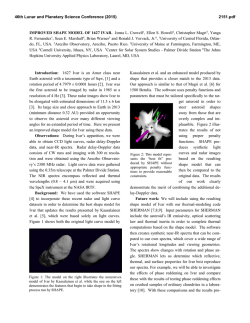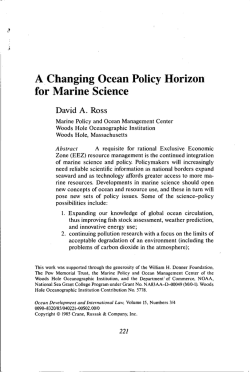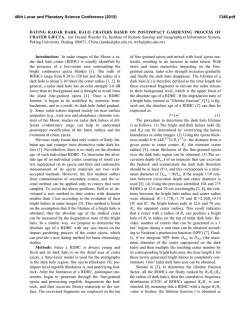
FY 2005 PI Report
Radar-based Detection, Tracking and Speciation of Marine Mammals From Ships Phone: (703) 413-0290 Dr. Douglas F. DeProspo Areté Associates 1550 Crystal Drive, Suite 703 Arlington, VA 22202 FAX: (703) 413-0295 E-mail: [email protected] Dr. Joseph Mobley University of Hawaii-West Oahu 96-129 Ala Ike Pearl City, HI 96782 Phone: (808) 454-4716 FAX: (808) 454-4715 E-mail: [email protected] Dr. Wai Hom The Johns Hopkins University Applied Physics Laboratory Air Defense Systems Department 11100 Johns Hopkins Road Laurel MD 20723-6099 Phone: (240) 228-5288 E-mail: [email protected] Dr. Mike Carron SACLANT Undersea Research Centre APO, AE 09613-5000 E-mail: [email protected] Award Number: N00014-04-1-0729 http://www.lsro.org/ECOUS/frames_home.asp LONG-TERM GOALS In addition to ship strikes, another cause of marine mammal injury and death is from exposure to high acoustic source levels, e.g., those encountered during Navy-sponsored Low Frequency Active (LFA) sonar tests. Irrespective of the method of mammal injury or death, the act of injuring or killing whales can and does result in litigation proceedings. This is a consequence of the legal protection that Cetaceans (whales and dolphins) are granted in U.S. waters by the Marine Mammal Protection Act of 1972 (as amended in 1994), with some species additionally protected by the Endangered Species Act of 1973. Previously developed mitigation technologies, such as passive acoustic and visual observation, although promising, still fall significantly short of achieving the detection performance necessary to achieve full marine mammal mitigation. Radar surveillance technology, being developed under the current supported program, represents a fundamental paradigm shift and new approach toward the goal of achieving robust marine mammal mitigation. Figure 1 shows an example of two humpbacks detected at a range of 8 km. in both a high-powered EO telescope (right-panel) and in simultaneous, co-registered radar imagery (left-panel) during a prior funded cliff-based demonstration of this Visible Figure 1 Right Panel: Visible image of two humpback whales. Left Panel: Simultaneous radar image of the same two whales. technology [1]. During FY05, under this grant, we have successfully demonstrated this technology for the first time from a ship-based platform during an experiment called CEDAR (“CEtacean Detection radAR”). The eventual long-term goal of this work, if successful under the baseline and option programs, is to develop and transition this new radar surveillance technology to both the military and commercial fleets. The primary benefit would be the mitigation of harmful effects on marine mammals due to acoustic testing and ship strikes. OBJECTIVES The overall objective of the baseline effort is to establish the ability of current or planned ship-based radars, augmented by specialized signal processing, to detect, discriminate and track (geo-locate) a number of different marine mammal species (e.g., great whales, schooling dolphins, etc.) under a variety of representative sea environments (e.g., Atlantic, Pacific, Mediterranean, etc.). If successful under the baseline effort, the main objective of a follow on effort would be to develop a prototype, near-real-time computer code stream capable of supporting the marine mammal mission under realistic and operational circumstances. Demonstration and validation of the performance of this near-real-time code stream would be performed under an at sea experiment similar to the exercise conducted under the baseline program. APPROACH AND WORK PLAN Our approach, under the current baseline program, is to establish, through a robust program of experiment, modeling and simulation, the ability of current or planned ship-based radars to detect, discriminate and track against a significant number of mammal species. Underpinning the execution of this technical approach are three key capabilities: The ability to model the radar signature of marine mammals as well as those of competing ocean clutter; the ability to design specialized and implementable signal-processing algorithms to enable the detection, tracking and discrimination of marine mammals; the ability to design and execute complex sea-tests in mammal-rich environments for demonstration and validation. Individuals key to the execution of the baseline program include: 1. Dr. Douglas DeProspo (Areté Associates): Overall project lead and coordinator. 2. Dr. Clayton Chinn (Areté Associates): Expert on specialized radar signal processing algorithm development and radar signal modeling. 3. Dr. Joseph Mobley (MMRC Ltd.): Expert on marine mammal behavior and biological characteristics (focus on Pacific and Atlantic species) and visual observation techniques. 4. Dr. Michael Carron (SACLANT Undersea Research Centre): Expert on marine mammal behavior and biological characteristics (focus on Mediterranean species) and visual observation techniques. 5. Dr. Wai Hom (Johns Hopkins University Applied Physics Laboratory): Expert on radar hardware/software interface development. Specific work to be executed during FY06 includes: 1. An advanced detection/tracking and preliminary discrimination code stream will be completed. 2. Further analysis of the CEDAR test data will be undertaken and empirical Probability of detection (Pd) and Probability of false-alarm (Pf) estimates will be made against fin whales and stenella dolphins. 3. An initial demonstration of marine mammal discrimination from other maritime targets will be made. 4. Theoretical Radar Cross Sections models will be derived for fin whales and stenella dolphins and compared to CEDAR-derived empirical models 5. Candidate platform/sensor combinations will be identified which are capable of supporting the sensor sampling and platform requirements necessary to effectively execute detection and tracking of marine mammals. WORK COMPLETED The most significant work achieved under this grant for the current period was the successful execution of a large-scale, multi-week, ship-based CEDAR demonstration experiment in the Mediterranean Sea. The experiment resulted in the collection of over 3 terabytes of radar data against a variety of marine mammals with approximately a terabyte of video data collected to corroborate radar detections. A baseline radar detection and tracking code stream was implemented and data from the CEDAR experiment were processed through this code stream and results analyzed. An advanced radar detection and tracking code stream was delineated, partially implemented and tested on CEDAR data. A discrimination capability was also delineated. RESULTS Initial analysis results of the CEDAR experiment demonstrate the feasibility of detecting and tracking fin whales and smaller mammals such as stenella dolphins at distances up to 5.5 km or more at lower sea states. An example detection and tracking example is shown in Figure 2. k1 c a r T k2 c a r T k3 c a Tr Figure 2 Top Panel: Radar-derived tracks of three detected stenella dolphins. Bottom Panel: Optical Image of a stenella dolphin during this sequence. In one case, we were able to track a pod of three fin whales continuously for more than three hours. Separation of individual pod members was also demonstrated. In addition, rarer species such as Ziphius beaked whale and Risso’s dolphin were also shown to be detectable. These results coupled with prior results achieved during Project Humpback [1] show the efficacy of radar-based surveillance technology as applied to the problem of detecting and tracking a broad class of marine mammals. IMPACT AND APPLICATIONS National Security Improved ability of naval forces to operate effectively during active sonar tests as well as during operational exercises, in areas containing marine mammals. The Coast Guard will also realize benefit via improved mammal awareness, thereby avoiding potential ship strikes, during the execution of its Maritime Domain Awareness Mission. Economic Development It is envisioned that ultimately a value-added radar surveillance hardware/software product package will be transitioned to private sector fleets, including fast ferries and oil exploration ship platforms, both of which utilize maritime surveillance radars. Primary benefit will be in the form of law suit mitigation; collision avoidance improvement in the case of fast-ferry induced ship strikes and improved environmental awareness for oil exploration platforms utilizing acoustic sounding to identify new petroleum reserves in mammal populated waters. Quality of Life Quality of life of marine mammals will be enhanced via the successful transition of this new radar technology to the government and private sectors. As discussed above, this technology will serve to mitigate risk to marine mammal species in the vicinity of acoustic testing as well as those in the vicinity of shipping lanes. Additional benefit could be realized in the form of improved capability for marine mammal census; migration of this new radar technology to aircraft platforms would enable the ability to search areas as large as 10,000 nm2 in 8 hours to categorize marine mammal populations. RELATED PROJECTS 1) Areté Associates’ Office of Naval Research (ONR) STTR Phase II Contract No. N00014-02-C0360, regarding “Radar Detection of Marine Mammals at Long Standoff”. Contract was completed November 1, 2004. 2) Scientific Solutions, Inc. ONR STTR Phase III Contract No. N00014-04-C-0451 regarding “Integrated Marine Mammal Monitoring and Protection System (IMAPS)”. Contract is still active. REFERENCES 1) DeProspo, D.F., “Radar Detection of Marine Mammals at Long Standoff-Phase II STTR Option Analysis of Project Humpback Data”. Areté Associates Internal Report (ARE-05-3439-005-FR), November 8, 2004 (Final Report delivered to the Office of Naval Research (ONR)). 2) DeProspo, D.F., Mobley, J., Forsyth, C., Chinn, C., Hom, W. and Soto, A. “Using Radar to Detect and Track Humpback Whales: Results of Project Humpback”. 15th Bienniel Conference of the Biology of Marine Mammals, Greensboro, N.C., 15-19 December, 2003 (Invited presentation with abstract published). 3) DeProspo, D.F., Mobley, J., Forsyth, C., Chinn, C., Hom, W. and Soto, A. “Project Humpback: A radar-based, humpback detection and tracking experiment”. Environmental Consequences of Underwater Sound (ECOUS) Symposium, San Antonio, Texas, 12-16 May 2003. (Invited presentation with abstract published). PUBLICATIONS 1) DeProspo, D.F., Mobley, J., Hom, W., Carron, M., D’Amico, A., Pavan, G., “Using Ship-mounted Radar to Detect and Track Cetaceans—Results of CEDAR Experiment”. 16th Bienniel Conference of the Biology of Marine Mammals, San Diego, CA., 11-15 December, 2005 (Invited presentation with abstract published)
© Copyright 2025





